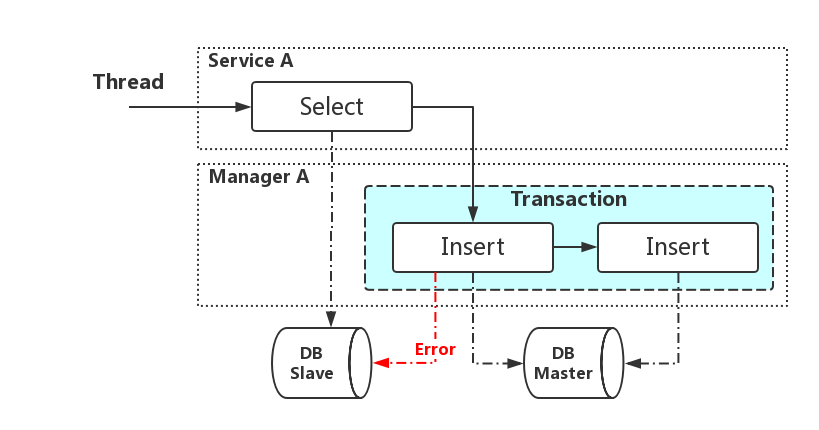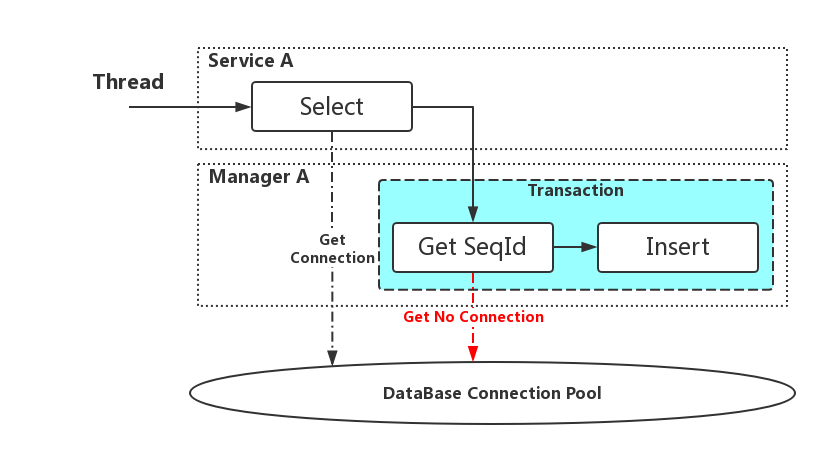資料庫讀寫分離與事務糾纏的那點坑
本篇文章討論在資料庫讀寫分離時使用事務的那些坑:
1. 在讀寫分離時會不會造成事務主從切換錯誤
一個執行緒在Serivcie時Select時選擇的是從庫,DynamicDataSourceHolder中ThreadLocal對應執行緒儲存的是slave,然後呼叫Manager時進入事務,事務使用預設的transacatinManager關聯的dataSource,而此時會不會獲取到的是slave?

2. 事務隔離級別和傳播特性會不會影響資料連線池死鎖
一個執行緒在Service層Select資料會從資料庫獲取一個Connection,通常來講,後續DB的操作在同一線執行緒會複用這個DB Connection,但是從Service進入Manager的事務後,Get Seq獲取全域性唯一標識,所以Get Seq一般都會開啟新的事物從DB Pool裡重新獲取一個新連線進行操作,但是問題是如果兩個事務關聯的datasource是同一個,即DB Pool是同一個,那麼如果DB Pool已經為空,是否會造成死鎖?

為了減輕資料庫的壓力,一般會進行資料庫的讀寫分離,實現方法一是通過分析sql語句是insert/select/update/delete中的哪一種,從而對應選擇主從,二是通過攔截方法名稱的方式來決定主從的,如:save*()、insert*() 形式的方法使用master庫,select()開頭的使用slave庫。
通常在方法上標上自定義標籤來選擇主從。
|
1 2 |
|
或者通過攔截器動態選擇主從。
|
1 2 3 4 5 6 7 8 |
key="slave" value="save,insert,add,create,update,delete,remove,gain"/>
|
讀寫動態庫配置
|
1 2 3 4 5 6 7 8 9 10 |
|
DynamicDataSource:
定義動態資料來源,實現通過整合Spring提供的AbstractRoutingDataSource,只需要實現determineCurrentLookupKey方法即可,由於DynamicDataSource是單例的,執行緒不安全的,所以採用ThreadLocal保證執行緒安全,由DynamicDataSourceHolder完成。
|
1 2 3 4 5 6 7 |
|
DynamicDataSourceHolder類:
|
1 2 3 4 5 6 7 8 9 10 11 12 13 14 15 16 17 18 19 20 21 22 23 24 25 26 27 28 29 30 31 |
|
動態設定資料來源可以通過Spring AOP來實現,而AOP切面的方式也有很多種。
Spring AOP的原理:Spring AOP採用動態代理實現,在Spring容器中的bean會被代理物件代替,代理物件里加入了增強邏輯,當呼叫代理物件的方法時,目標物件的方法就會被攔截。
事務切面和讀/寫庫選擇切面
|
1 2 3 4 5 6 7 8 9 |
|
Java邏輯:
|
1 2 3 4 5 6 7 8 9 10 11 12 13 14 15 16 17 18 19 20 21 22 23 24 25 |
|
使用BeanNameAutoProxyCreator建立代理
|
1 2 3 4 5 6 7 8 9 10 11 12 13 14 |
|
Java邏輯:
|
1 2 3 4 5 6 7 8 9 10 11 12 13 14 15 16 17 18 19 20 21 |
|
Spring的事務處理為了與資料訪問解耦,它提供了一套處理資料資源的機制,而這個機制採用ThreadLocal的方式。
事務管理器
Spring中通常通過@Transactional來宣告使用事務。如果@Transactional不指定事務管理器,使用預設。注意如果Spring容器中定義了兩個事務管理器,@Transactional標註是不支援區分使用哪個事務管理器的,Spring 3.0之後的版本Transactional增加了個string型別的value屬性來特殊指定加以區分。
|
1 2 3 4 5 |
|
同時進行XML配置
|
1 2 3 4 5 |
|
其中dataSource是在Spring配置檔案中定義的資料來源的物件例項。transaction-manager屬性儲存一個對在Spring配置檔案中定義的事務管理器bean的引用,如果沒有它,就會忽略@Transactional註釋,導致程式碼不會使用任何事務。proxy-target-class控制是基於介面的還是基於類的代理被建立,如果屬性值被設定為true,那麼基於類的代理將起作用,如果屬性值為false或者被省略,那麼標準的JDK基於介面的代理將起作用。
注意@Transactional建議在具體的類(或類的方法)上使用,不要使用在類所要實現的任何介面上。
(推薦閱讀:Spring事務隔離級別和傳播特性 http://www.cnblogs.com/zhishan/p/3195219.html)
SQL四類隔離級別
事務的實現是基於資料庫的儲存引擎。不同的儲存引擎對事務的支援程度不一樣。Mysql中支援事務的儲存引擎有InnoDB和NDB。InnoDB是mysql預設的儲存引擎,預設的隔離級別是RR(Repeatable Read)。
事務的隔離性是通過鎖實現,而事務的原子性、一致性和永續性則是通過事務日誌實現。
(推薦閱讀:資料庫事務與MySQL事務總結 https://zhuanlan.zhihu.com/p/29166694)
Q1 在讀寫分離時會不會造成事務主從切換錯誤
一個執行緒在Serivcie時Select時選擇的是從庫,DynamicDataSourceHolder中ThreadLocal對應執行緒儲存的是slave,然後呼叫Manager時進入事務,事務使用預設的transacatinManager關聯的dataSource,而此時會不會獲取到的是slave?
經驗證不會,但這是因為在AOP設定動態織出的時候,都要清空DynamicDataSourceHolder的ThreadLocal,如此避免了資料庫事務傳播行為影響的主從切換錯誤。如果Selelct DB從庫完成之後不清空ThreadLocal,那麼ThreadLocal跟執行緒繫結就會傳播到Transaction,造成事務操作從庫異常。而清空ThreadLocal之後,Spring的事務攔截先於動態資料來源的判斷,所以事務會切換成主庫,即使事務中再有查詢從庫的操作,也不會造成主庫事務異常。

Q2 事務隔離級別和傳播特性會不會影響資料連線池死鎖
一個執行緒在Service層Select資料會從資料庫獲取一個Connection,通常來講,後續DB的操作在同一線執行緒會複用這個DB Connection,但是從Service進入Manager的事務後,Get Seq獲取全域性唯一標識,所以Get Seq一般都會開啟新的事物從DB Pool裡重新獲取一個新連線進行操作,但是問題是如果兩個事務關聯的datasource是同一個,即DB Pool是同一個,那麼如果DB Pool已經為空,是否會造成死鎖?
經驗證會死鎖,所以在實踐過程中,如果有此實現,建議Get Seq不要使用與事務同一個連線池。或者採用事務隔離級別設定PROPAGATION_REQUIRES_NEW進行處理。最優的實踐是宎把Get SeqId放到事務裡處理。

架構視訊學習
分享一些架構學習的視訊資料,想要的可以自己去領取。
當然還有更多,這邊就不一一列舉了,你如果覺得你能全部吃下,也不擋著你要到更多。
歡迎加入Java高階架構學習交流群:939420159 本群提供免費的學習指導 架構資料 以及免費的解答 不懂得問題都可以在本群提出來 之後還會有職業生涯規劃以及面試指導 進群修改群備註:開發年限-地區-經驗 方便架構師解答問題 免費領取架構師全套視訊!!!!!!!!
